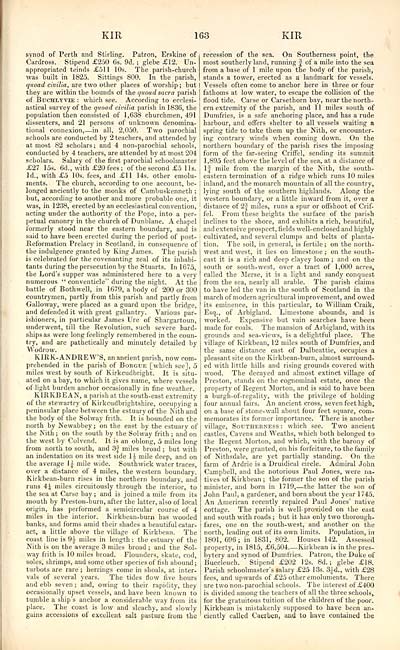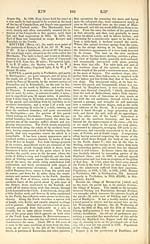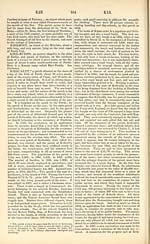Topographical, statistical, and historical gazetteer of Scotland > Volume 2
(175) Page 163
Download files
Complete book:
Individual page:
Thumbnail gallery: Grid view | List view

KIR
163
KIR
synod of Perth and Stirling. Patron, Erskine of
Cardross. Stipend £250 6s. 9d. ; glebe £12. Un-
appropriated teinds £.511 10s. The parish-church
was built in 1825. Sittings 800. In the parish,
quoad civilia, are two other places of worship ; but
they are within the bounds of the quoad sacra parish
of Buchlyvie : which see. According to ecclesi-
astical survey of the quoad civilia parish in 1836, the
population then consisted of 1,638 churchmen, 491
dissenters, and 21 persons of unknown denomina-
tional connexion, — in all, 2,050. Two parochial
schools are conducted by 2 teachers, and attended by
at most 82 scholars ; and 4 non-parochial schools,
conducted by 4 teachers, are attended by at most 204
scholars. Salary of the first parochial schoolmaster
£27 15s. 6d., with £20 fees; of the second £5 lis.
Id., with £5 10s. fees, and £11 14s. other emolu-
ments. The church, according to one account, be- j
longed anciently to the monks of Cambuskenneth ;
but, according to another and more probable one, it
was, in 1238, erected by an ecclesiastical convention,
acting under the authority of the Pope, into a per- ;
petual canonry in the church of Dunblane. A chapel
formerly stood near the eastern boundary, and is |
said to have been erected during the period of post-
Reformation Prelacy in Scotland, in consequence of
the indulgence granted by King James. The parish
is celebrated for the covenanting zeal of its inhabi-
tants during the persecution by the Stuarts. In 1675,
the Lord's supper was administered here to a very
numerous " conventicle" during the night. At the
battle of Bothwell, in 1679, a body of 200 or 300
countrymen, partly from this parish and partly from
Galloway, were placed as a guard upon the bridge,
and defended it with great gallantry. Various par-
ishioners, in particular James Ure of Shargartoun,
underwent, till the Revolution, such severe hard-
ships as were long feelingly remembered in the coun-
try, and are pathetically and minutely detailed by
Wodrow.
KIRK-ANDREW'S, an ancient parish, now com-
prehended in the parish of Borgue [which see], 5
miles west by south of Kirkcudbright. It is situ-
ated on a bay, to which it gives name, where vessels
of light burden anchor occasionally in fine weather.
KIRKBEAN, a parish at the south-east extremity
of the stewartry of Kirkcudbrightshire, occupying a
peninsular place between the estuary of the Nith and
the body of the Solway frith. It is bounded on the
north by Newabbey ; on the east by the estuary of
the Nith ; on the south by the Solway frith ; and on
the west by Colvend. It is an oblong, 5 miles long
from north to south, and 3;| miles broad ; but with
an indentation on its west side 1J mile deep, and on
the average 1£ mile wide. Southwick water traces,
over a distance of 4 miles, the western boundary.
Kirkbean-burn rises in the northern boundary, and
runs 4£ miles circuitously through the interior, to
the sea at Carse bay ; and is joined a mile from its
mouth by Preston-burn, after the latter, also of local
origin, has performed a semicircular course of 4
miles in the interior. Kirkbean-burn has wooded
banks, and forms amid their shades a beautiful catar-
act, a little above the village of Kirkbean. The
coast line is 9i miles in length : the estuary of the
Nith is on the average 3 miles broad ; and the Sol-
way frith is 10 miles broad. Flounders, skate, cod,
soles, shrimps, and some other species of fish abound ;
turbots are rare ; herrings come in shoals, at inter-
vals of several years. The tides flow five hours
and ebb seven ; and, owing to their rapidity, they
occasionally upset vessels, and have been known to
tumble a ship's anchor a considerable way from its
place. The coast is low and sleachy, and slowly
gains accessions of excellent salt pasture from the
recession of the sea. On Southerness point, the
most southerly land, running | of a mile into the sea
from a base of 1 mile upon the body of the parish,
stands a tower, erected as a landmark for vessels.
Vessels often come to anchor here in three or four
fathoms at low water, to escape the collision of the
flood tide. Carse or Carsethorn bay, near the north-
ern extremity of the parish, and 11 miles south of
Dumfries, is a safe anchoring place, and has a rude
harbour, and offers shelter to all vessels waiting a
spring tide to take them up the Nith, or encounter-
ing contrary winds when coming down. On the
northern boundary of the parish rises the imposing
form of the far-seeing Criffel, sending its summit
1 ,895 feet above the level of the sea, at a distance of
1J mile from the margin of the Nith, the south-
eastern termination of a ridge which runs 10 miles
inland, and the monarch mountain of all the country,
lying south of the southern highlands. Along the
western boundary, or a little inward from it, over a
distance of 2J miles, runs a spur or offshoot of Crif-
fel. From these heights the surface of the parish
inclines to the shore, and exhibits a rich, beautiful,
and extensive prospect, fields well-enclosed and highly
cultivated, and several clumps and belts of planta-
tion. The soil, in general, is fertile; on the north-
west and west, it lies on limestone ; on the south-
east it is a rich and deep clayey loam ; and on the
south or south-west, over a tract of 1,000 acres,
called the Merse, it is a light and sandy conquest
from the sea, nearly all arable. The parish claims
to have led the van in the south of Scotland in the
march of modern agricultural improvement, and owed
its eminence, in this particular, to William Craik,
Esq., of Arbigland. Limestone abounds, and is
worked. Expensive but vain searches have been
made for coals. The mansion of Arbigland, with its
grounds and sea-views, is a delightful place. The
village of Kirkbean, 12 miles south of Dumfries, and
the same distance east of Dalbeattie, occupies a
pleasant site on the Kirkbean-burn, almost surround-
ed with little hills and rising grounds covered with
wood. The decayed and almost extinct village of
Preston, stands on the cognominal estate, once the
property of Regent Morton, and is said to have been
a burgh-of-regality, with the privilege of holding
four annual fairs. An ancient cross, seven feet high,
on a base of stone-wall about four feet square, com-
memorates its former importance. There is another
village, Southerness : which see. Two ancient
castles, Cavens and Weaths, which both belonged to
the Regent Morton, and which, with the barony of
Preston, were granted, on his forfeiture, to the family
of Nithsdale, are yet partially standing. On the
farm of Ardrie is a Druidical circle. Admiral John
Campbell, and the notorious Paul Jones, were na-
tives of Kirkbean ; the former the son of the parish
minister, and born in 1719, — the latter the son of
John Paul, a gardener, and born about the year 1745.
An American recently repaired Paul Jones' native
cottage. The parish is well- provided on the east
and south with roads ; but it has only two thorough-
fares, one on the south-west, and another on the
north, leading out of its own limits. Population, in
1801, 696; in 1831, 802. Houses 142. Assessed
property, in 1815, £6,504 Kirkbean is in the pres-
bytery and synod of Dumfries. Patron, the Duke of
Buccleuch. Stipend £202 12s. 8d. ; glebe £18.
Parish schoolmaster's salary £25 13s. 3J-d., with £28
fees, and upwards of £25 other emoluments. There
are two non-parochial schools. The interest of £400
is divided among the teachers of all the three schools,
for the gratuitous tuition of the children of the poor.
Kirkbean is mistakenly supposed to have been an-
ciently called Caerben, and to have contained the
163
KIR
synod of Perth and Stirling. Patron, Erskine of
Cardross. Stipend £250 6s. 9d. ; glebe £12. Un-
appropriated teinds £.511 10s. The parish-church
was built in 1825. Sittings 800. In the parish,
quoad civilia, are two other places of worship ; but
they are within the bounds of the quoad sacra parish
of Buchlyvie : which see. According to ecclesi-
astical survey of the quoad civilia parish in 1836, the
population then consisted of 1,638 churchmen, 491
dissenters, and 21 persons of unknown denomina-
tional connexion, — in all, 2,050. Two parochial
schools are conducted by 2 teachers, and attended by
at most 82 scholars ; and 4 non-parochial schools,
conducted by 4 teachers, are attended by at most 204
scholars. Salary of the first parochial schoolmaster
£27 15s. 6d., with £20 fees; of the second £5 lis.
Id., with £5 10s. fees, and £11 14s. other emolu-
ments. The church, according to one account, be- j
longed anciently to the monks of Cambuskenneth ;
but, according to another and more probable one, it
was, in 1238, erected by an ecclesiastical convention,
acting under the authority of the Pope, into a per- ;
petual canonry in the church of Dunblane. A chapel
formerly stood near the eastern boundary, and is |
said to have been erected during the period of post-
Reformation Prelacy in Scotland, in consequence of
the indulgence granted by King James. The parish
is celebrated for the covenanting zeal of its inhabi-
tants during the persecution by the Stuarts. In 1675,
the Lord's supper was administered here to a very
numerous " conventicle" during the night. At the
battle of Bothwell, in 1679, a body of 200 or 300
countrymen, partly from this parish and partly from
Galloway, were placed as a guard upon the bridge,
and defended it with great gallantry. Various par-
ishioners, in particular James Ure of Shargartoun,
underwent, till the Revolution, such severe hard-
ships as were long feelingly remembered in the coun-
try, and are pathetically and minutely detailed by
Wodrow.
KIRK-ANDREW'S, an ancient parish, now com-
prehended in the parish of Borgue [which see], 5
miles west by south of Kirkcudbright. It is situ-
ated on a bay, to which it gives name, where vessels
of light burden anchor occasionally in fine weather.
KIRKBEAN, a parish at the south-east extremity
of the stewartry of Kirkcudbrightshire, occupying a
peninsular place between the estuary of the Nith and
the body of the Solway frith. It is bounded on the
north by Newabbey ; on the east by the estuary of
the Nith ; on the south by the Solway frith ; and on
the west by Colvend. It is an oblong, 5 miles long
from north to south, and 3;| miles broad ; but with
an indentation on its west side 1J mile deep, and on
the average 1£ mile wide. Southwick water traces,
over a distance of 4 miles, the western boundary.
Kirkbean-burn rises in the northern boundary, and
runs 4£ miles circuitously through the interior, to
the sea at Carse bay ; and is joined a mile from its
mouth by Preston-burn, after the latter, also of local
origin, has performed a semicircular course of 4
miles in the interior. Kirkbean-burn has wooded
banks, and forms amid their shades a beautiful catar-
act, a little above the village of Kirkbean. The
coast line is 9i miles in length : the estuary of the
Nith is on the average 3 miles broad ; and the Sol-
way frith is 10 miles broad. Flounders, skate, cod,
soles, shrimps, and some other species of fish abound ;
turbots are rare ; herrings come in shoals, at inter-
vals of several years. The tides flow five hours
and ebb seven ; and, owing to their rapidity, they
occasionally upset vessels, and have been known to
tumble a ship's anchor a considerable way from its
place. The coast is low and sleachy, and slowly
gains accessions of excellent salt pasture from the
recession of the sea. On Southerness point, the
most southerly land, running | of a mile into the sea
from a base of 1 mile upon the body of the parish,
stands a tower, erected as a landmark for vessels.
Vessels often come to anchor here in three or four
fathoms at low water, to escape the collision of the
flood tide. Carse or Carsethorn bay, near the north-
ern extremity of the parish, and 11 miles south of
Dumfries, is a safe anchoring place, and has a rude
harbour, and offers shelter to all vessels waiting a
spring tide to take them up the Nith, or encounter-
ing contrary winds when coming down. On the
northern boundary of the parish rises the imposing
form of the far-seeing Criffel, sending its summit
1 ,895 feet above the level of the sea, at a distance of
1J mile from the margin of the Nith, the south-
eastern termination of a ridge which runs 10 miles
inland, and the monarch mountain of all the country,
lying south of the southern highlands. Along the
western boundary, or a little inward from it, over a
distance of 2J miles, runs a spur or offshoot of Crif-
fel. From these heights the surface of the parish
inclines to the shore, and exhibits a rich, beautiful,
and extensive prospect, fields well-enclosed and highly
cultivated, and several clumps and belts of planta-
tion. The soil, in general, is fertile; on the north-
west and west, it lies on limestone ; on the south-
east it is a rich and deep clayey loam ; and on the
south or south-west, over a tract of 1,000 acres,
called the Merse, it is a light and sandy conquest
from the sea, nearly all arable. The parish claims
to have led the van in the south of Scotland in the
march of modern agricultural improvement, and owed
its eminence, in this particular, to William Craik,
Esq., of Arbigland. Limestone abounds, and is
worked. Expensive but vain searches have been
made for coals. The mansion of Arbigland, with its
grounds and sea-views, is a delightful place. The
village of Kirkbean, 12 miles south of Dumfries, and
the same distance east of Dalbeattie, occupies a
pleasant site on the Kirkbean-burn, almost surround-
ed with little hills and rising grounds covered with
wood. The decayed and almost extinct village of
Preston, stands on the cognominal estate, once the
property of Regent Morton, and is said to have been
a burgh-of-regality, with the privilege of holding
four annual fairs. An ancient cross, seven feet high,
on a base of stone-wall about four feet square, com-
memorates its former importance. There is another
village, Southerness : which see. Two ancient
castles, Cavens and Weaths, which both belonged to
the Regent Morton, and which, with the barony of
Preston, were granted, on his forfeiture, to the family
of Nithsdale, are yet partially standing. On the
farm of Ardrie is a Druidical circle. Admiral John
Campbell, and the notorious Paul Jones, were na-
tives of Kirkbean ; the former the son of the parish
minister, and born in 1719, — the latter the son of
John Paul, a gardener, and born about the year 1745.
An American recently repaired Paul Jones' native
cottage. The parish is well- provided on the east
and south with roads ; but it has only two thorough-
fares, one on the south-west, and another on the
north, leading out of its own limits. Population, in
1801, 696; in 1831, 802. Houses 142. Assessed
property, in 1815, £6,504 Kirkbean is in the pres-
bytery and synod of Dumfries. Patron, the Duke of
Buccleuch. Stipend £202 12s. 8d. ; glebe £18.
Parish schoolmaster's salary £25 13s. 3J-d., with £28
fees, and upwards of £25 other emoluments. There
are two non-parochial schools. The interest of £400
is divided among the teachers of all the three schools,
for the gratuitous tuition of the children of the poor.
Kirkbean is mistakenly supposed to have been an-
ciently called Caerben, and to have contained the
Set display mode to: Large image | Transcription
Images and transcriptions on this page, including medium image downloads, may be used under the Creative Commons Attribution 4.0 International Licence unless otherwise stated. ![]()
| Gazetteers of Scotland, 1803-1901 > Topographical, statistical, and historical gazetteer of Scotland > Volume 2 > (175) Page 163 |
|---|
| Permanent URL | https://digital.nls.uk/97450690 |
|---|
| Description | Volume second: I-Z. |
|---|---|
| Shelfmark | Map Room Ref.2 |
| Attribution and copyright: |
|

